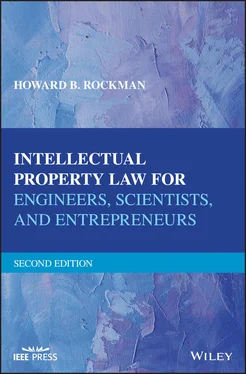My thanks also go out to two fine attorneys who assisted me in the preparation of the biotechnology patent and cybersquatting chapters of this text, Krista Vink Vinegas ( krista.vinegas@morganlewis.com) and Peter Berk ( pberk@fvldlaw.com). In addition, U.K. patent attorney James Leach ( james.leach@mewburn.com), a member of the Mewburn Ellis firm, contributed mightily to the portion of this text on the patent eligibility of computer‐related inventions in Europe. Credit is also due to Richard Gruner ( 7gruner@jmls.edu), former director, Center for Intellectual Property, John Marshall Law School, Chicago, Illinois, for his contributions to the coverage of international intellectual property creation, protection, and enforcement. My law partner, Mercedes V. O’Connor, deserves the highest accolades for getting me through the computer‐related material included in this text. My having gone through engineering school with only a slide rule, since computers were not available then, her assistance was invaluable.
My thanks also go out to William T. McGrath, an excellent copyright law attorney with the Chicago law firm of Davis and McGrath, who provided guidance to me on the intricacies of copyright law, including the Digital Millennium Copyright Act (DMCA). Bill has taught copyright law at John Marshall Law School for many years, and I have the utmost respect for his wisdom in the mysterious ways of copyright law.
This text could not have been produced without the able assistance of Sharen Lahti and Susan Kilburg. Without them, the pages of this work may have been chiseled on stone tablets.
Hearty thanks also are due to the National Inventors Hall of Fame, whose website provided the starting point for my idea to include brief biographies of inventors and inventions between the chapters of both the first and second editions of this text. I also want to thank all of the authors of the many research materials given attribution in my bibliographies. The hardest part of preparing the inventors and inventions essays was deciding which fascinating facts about these enlightened individuals had to be omitted for the sake of brevity. My thanks also extend to Anthony Loder, son of famed actress/inventor Hedy Lamarr, for furnishing me with first‐hand knowledge about his mother’s invention of what is known today as spread spectrum technology .
For assistance in researching the history of the Wright Brothers, my appreciation is extended to Ronald C. Young, a local historian from Blue Island, Illinois. My essay on Nikola Tesla would not have been possible without the kind cooperation of the wonderful people at the Nikola Tesla Museum, Belgrade, Serbia, and the Antique Wireless Association of the United States. Also, my hand is extended to Paul Schatzkin for furnishing me with invaluable documentation on the Farnsworth–Zworykin patent battle.
Maxwell Rockman deserves a well‐earned thank you for conducting the preliminary research for the inventors and inventions essays in the first edition, while I struggled to keep up with my daytime vocation as an intellectual property attorney. Maxwell, your service was well above and beyond the call of duty.
Debbie Greenberg researched and prepared several of the inventors and inventions essays included in this second edition, and my warmest appreciation extends to her.
JoAnn Rockman, my wife of 34 years, deserves more expressions of appreciation than I am capable of giving. First, she had to tolerate my “lack of attention” while the underlying UIC course materials were developed. Then, she had to stand by and watch while her spouse pored over the papers and research material to prepare 36 chapters of text and the numerous inventors and inventions essays. As a consolation, I now have turned control of the dining room table back to her and the family.
Howard B. Rockman
rockman@rvoiplaw.com
Top Ten List of Intellectual Property Protection
There are several important points regarding the potential loss of intellectual property rights by the actions of an inventor or creator, and other matters, that warrant special and advanced mention. Adherence to these points will help you avoid the unintended loss of rights to your novel technology. Each of these matters is discussed in detail in this text, but I want to prevent the potential loss of intellectual property rights until you get to the appropriate page.
1 Do not publicly disclose your patentable invention to anyone outside your development team until either a provisional or non‐provisional patent application covering your invention has been filed with the USPTO, or your respective home patent office. In the United States, in broad terms, an inventor has 1 year following the public disclosure of an invention to file a patent application. However, public knowledge of your invention anywhere will destroy all patent rights in most countries outside the United States. These countries adhere to the “absolute novelty” rule that requires a patent application to be filed covering an invention in the inventor’s home country before any public disclosure of the invention. Thus, by filing your patent application in your home country before any public disclosure of the invention, you have saved all of your international patent rights. If you must disclose your invention to another before a patent application can be filed, have the recipient of the disclosure sign a confidential non‐disclosure agreement before receiving the information. This makes the disclosure “non‐public,” and saves your patent rights.
2 Even though you obtain a patent on your invention, products or processes incorporating your invention may still infringe the patent rights of someone else. Therefore, my advice is to have a freedom‐to‐use search conducted before you bring your new, and patentable, product to market.
3 Be sure you advise your patent attorney of all prior art relating to your invention that you are aware of before the patent application covering your invention is filed, and during the pendency of your application. It is a strict requirement that all material prior art publications and activities of which you are aware be submitted to the U.S. patent examiner.
4 Since the United States has adopted the “first‐to‐file” system, if you are working in a highly competitive industry, your patent application, provisional or non‐provisional, should be prepared and filed at the earliest practical time.
5 When beginning a new employment, carefully read and fully understand the agreements you sign, particularly the language regarding ownership of inventions made prior to your employment, and those inventions made during your employment. Also make sure you understand any language that may affect your ability to work for a competitor if and when your new employment terminates.
6 If you are adopting a name, trademark, logo, etc., for use in your business, have a search conducted to ensure that someone else in the same or a similar line of business is not already using a confusingly similar name or symbol.
7 When asking a vendor or supplier to provide input to a development project, have the vendor first sign an agreement that any contribution they make toward the development of protectable intellectual property will belong to you or your company, and not to the vendor.
8 If you intend to maintain certain information as trade secrets, fully inform yourself of the steps you legally have to take to prove later that you have in place a strict policy and safeguards for maintaining the secrecy of all confidential information.
9 The copyright law prevents copying. You may set forth a previously written‐about concept or development in your own words, but do not copy the same expression of that concept as used by someone else.
10 Consider initially that any new development you produce may be patentable, or may be covered by one or more of the other intellectual property vehicles. Just as science and technology changes, intellectual property laws also change to protect new forms of innovation.
Читать дальше












